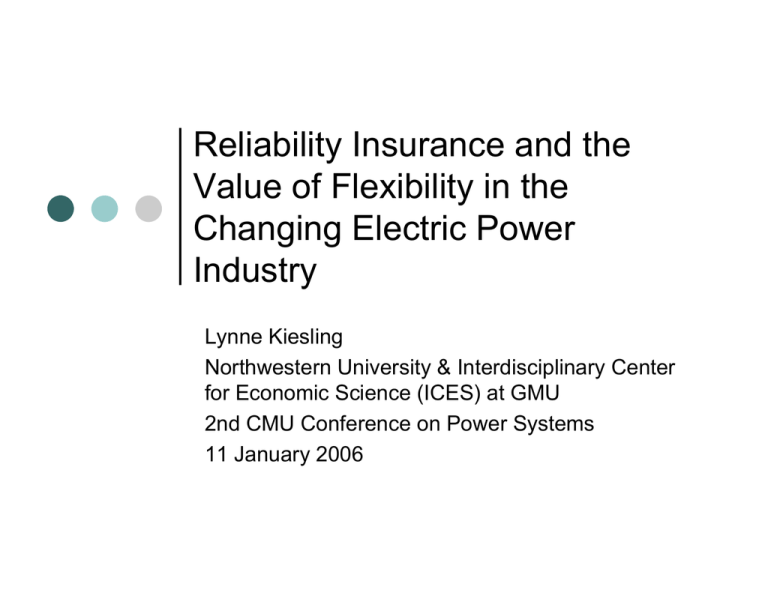Reliability Insurance and the Value of Flexibility in the Changing Electric Power Industry
advertisement

Reliability Insurance and the Value of Flexibility in the Changing Electric Power Industry Lynne Kiesling Northwestern University & Interdisciplinary Center for Economic Science (ICES) at GMU 2nd CMU Conference on Power Systems 11 January 2006 Economic Aspects of Sensing Technologies | | | | | Benefit-cost analysis Valuation of using technology to avoid failures due to large events Comparison of this value to cost of maintaining reserve margins Ability of reliability insurance to provide decentralized reliability mechanism Infrastructure requirements to enable decentralized reliability Valuation of Benefits of Sensing Hardware/Software | Ability to avoid large-event-induced failures z z | | | | Supply: enables islanding to avoid cascading failure Demand: large variations connected with equipment failure (can sensing prevent this failure, or just make it easier to find them ex post?) Fault detection: prevention cheaper than recovery Automation of routine maintenance tasks increases reliability Enhanced resilience if coupled with repair processes Reduces entry barriers for DG and demand participation Valuation of Costs of Sensing Hardware/Software Implementation, purchase costs | System integration | Others? | Net Benefit Comparison | | Net benefit = benefits-costs How does net benefit of sensing compare to cost of maintaining reserve margins? z | | Opportunity cost of foregone sales + cost of additional generation construction Can sensing technology enable us to increase load factor while simultaneously increasing reliability? Others? Sensing and Differentiated Reliability Claim: end-use customers have different preferences over reliability, and different risk preferences | Sensing technology further enables the sale of reliability as a differentiated product, thus increasing economic surplus | Selling differentiated reliability further contributes to network resiliency, even at higher load factors | Reliability Insurance A contractual means of selling differentiated reliability | Customers “buy their place in line” | In the process, customers reveal valuable, heretofore unknown, information about how they value reliability | Infrastructure Requirements Distributed sensing and control technologies | Others? | Conclusion | | | | Valuing the implementation of sensing technology is difficult Some of the unseen value relates to enhanced reliability through products like reliability insurance The benefit of reduced transaction costs => more robust, integrated competitive markets is hard to quantify More research is needed!






